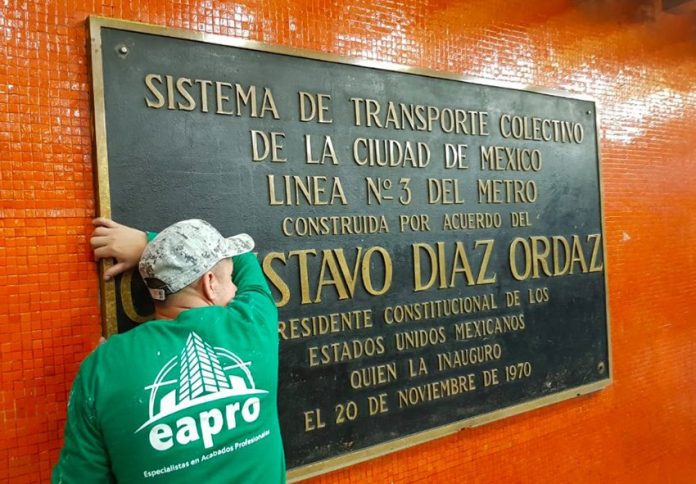Fifty years after the 1968 Tlatelolco massacre, plaques honoring the president who authorized the use of force against peaceful protesters are coming down and monuments to him could soon follow.
As many as 300 students were killed in Mexico City on October 2, 1968, amid rising social tensions and just 10 days before the opening of the Mexico City Summer Olympics, President Gustavo Díaz Ordaz ordered the use of military force against students demonstrating against authoritarian rule.
Army and police helicopters dropped flares on the square and snipers shot at students before soldiers and tanks opened fire on the gathered masses in Tlatelolco’s Plaza de las Tres Culturas (Square of the Three Cultures), located just north of the capital’s historic center.
Officials maintained that only 30 people lost their lives but based on witness accounts and reporting from foreign correspondents, it is believed that the real number was around 300 victims. More than 1,000 students were arrested during and after the massacre.
Last week, a federal government agency, the Victims’ Commission, recognized for the first time that the massacre was “a state crime that continued beyond October 2 with arbitrary arrests and torture.”
Yesterday, the day before the 50th anniversary of the atrocity, Mexico City Mayor José Ramón Amieva Gálvez announced that all plaques in the capital’s subway system recognizing federal or city authorities in power in 1968 would be removed immediately.
The metro system was built during Ordaz’s six-year presidency and its first line started operations in 1969, a year before he left office.
Amieva said that after taking into account the thoughts and feelings of citizens, he came to the conclusion that the time was right to remove references to the former president.
The plaques will be replaced with new ones that offer information about the construction of the metro but make no mention of the authorities who oversaw the project.
The move was praised by many on social media but others condemned it, not out of defense for Díaz Ordaz’s legacy but because it would erase one of the darkest chapters of Mexico’s history from citizens’ collective consciousness.
“The Mexico City government has ordered plaques with the name Gustavo Díaz Ordaz be removed. In the same spirit, Stalin ordered the faces of his adversaries to be removed from paintings and photographs. History is not altered by decree nor by erasing its testimonies. History is explained and discussed,” National Autonomous University (UNAM) academic Raúl Trejo Delarbre wrote on Twitter.
“Not by removing plaques with the name of Gustavo Díaz Ordaz from metro stations will it cease to be a historic fact that the SCT [subway system] was built in his six-year term. History is not . . . black and white. It has to be respected. Mexicans have a right to memory,” journalist Pascal Beltrán del Río said.
Ignacio Lanzagorta, an anthropologist and political scientist, argued that the plaques should remain but new ones should be added below to explain “who the hell Díaz Ordaz is” and “to broaden the perspective” about what happened during his administration.
In Nuevo León, academics and activists belonging to the 9 de Marzo Collective called on local authorities to pull down monuments that honor the former Institutional Revolutionary Party (PRI) president and to change the name of any streets, neighborhoods or places that bear his name.
Members of the group recommended that “Martyrs of October 2, 1968” be used as a replacement name.
“The former president disgraced not just the Mexican army but the whole nation. During his fifth government report, on September 1, 1969, Díaz Ordaz declared that he was personally responsible [for the massacre] from the moral, ethical and historic point of view,” said Juan de Dios Sánchez Martínez, an activist in the northern state.
Members of the activist group presented a petition to the mayor of Monterrey to support their position and also submitted a list of all the streets, neighborhoods and monuments that honor Díaz Ordaz.
Marches will take place in at least 18 Mexican states today to commemorate the massacre but as always the largest protest will take place in Mexico City.
Thousands of people are expected to march from the Plaza de las Tres Culturas to the zócalo, Mexico City’s central square.
Among the participants will be the parents of the 43 students who disappeared in Iguala, Guerrero, in 2014.
They took to the streets of the capital just a week ago to mark the fourth anniversary of their sons’ disappearance after meeting earlier with president-elect López Obrador, who pledged that the incoming government would find the truth of what happened and examine the role of the army and Federal Police.
Now, as in 1968, impunity continues to prevail in many cases of violence committed in the country.
The disappearance and presumed death of the 43 rural students provided a stark reminder that Mexico can still be a dangerous place for students, with powerful drug cartels presenting the biggest risk to the nation’s youth.
According to the federal government’s “historic truth” regarding the Ayotzinapa-Iguala case, the 43 students were killed by a local crime gang who later burned their bodies in a municipal dump.
This year, the Jalisco New Generation Cartel (CJNG) is believed responsible for kidnapping, torturing and murdering three film students in Jalisco.
“We are possibly worse off today. Young people are under attack, with the economy, inequality, there are fewer opportunities,” Enrique Espinosa, a participant in the 1968 protests, told the Associated Press.
“This is not the Mexico we wanted,” he declared.
Source: Animal Político (sp), Reporte Indigo (sp), El Universal (sp), AP (en)
